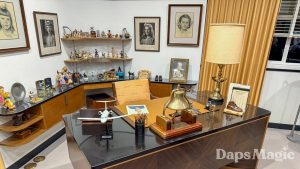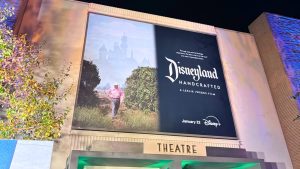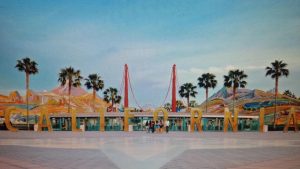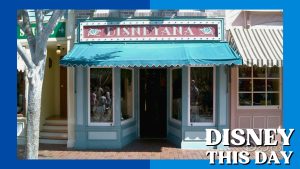Derric Johnson was the founder of the popular Voices of Liberty vocal group at EPCOT. This a cappella group has been singing and delighting guests since the park opened on October 1, 1982. At the time, there was no clue at how much love an acclaim the group would receive through the years. In fact, it wasn’t even expected to last a single year!
Recently, the arranger/composer sat down with D23 to talk about the early days of the Voices of Liberty. Undoubtably, he has many more stories and memories to share than what was included in the interview. However, the memories are still magical and it is fun to see where the group came from as the group’s songs continue to be heard with the amazing acoustics of the America Pavilion.
D23: The Voices of Liberty was an opening day feature of EPCOT. What do you remember about the very first performance?
Derric Johnson: Just before opening day, we opened the park for three days for special guests, including construction workers, [Disney] Entertainment [division] people, and political figures, as I recall. It was amazing. And on that first day we sang, there were two people who stood waiting after the last set, like they wanted to talk—this very lovely lady and her husband leaning against one of the pillars of The American Adventure rotunda. And she said, “I just wanted you to know that hearing you sing, hearing your group, was wonderful. And I’d just like you to know that, of everything that happened today—all the great shows and displays—this would’ve been my father’s favorite.” I said, “Thank you very much,” and she shook my hand and walked away. One of the Operations people rushed up to me and goes, “You know who that was?” I said, “Just a very nice lady.” They said, “That was Diane Disney [Miller], Walt’s oldest daughter.” And I thought, “Wow—what a great thing for her to say, you know?” So that’s my memory of the first day. It started off pretty cool…
Why do you think the Voices of Liberty works so well within EPCOT and has lasted this long as a Walt Disney World entertainment offering?
A lot of that really has to do, I think, with the philosophy of our show. Because we’re in the rotunda, and it’s a flat floor and we have people sit down… It’s a very relational show, because we’re not on a stage—we’re just right at the people. And we do things to involve the crowd and make them feel part of the show.
We had an arrangement we always did of “Oh! Susanna,” where we sang banjo (“ding-a-ning-a-ning-a-ning,” you know?). And a soloist would go out and take a lady’s hand, sing to her, and then we had a kind of slapstick sort of thing where it seemed like she was pulling him back to her, and people laughed. It was great. And we did “Skip to My Lou,” where a lady would sing to an 8- or 9-year-old boy and enter into a bit of a conversation; have him come stand with her.
So, it was very relational. Plus, we were the first group at [Walt Disney World] that ever did [a] meet and greet. I had been told we couldn’t do that—but in my background, that’s what we always did, because we just want to be with people, you know? So we arranged it that the singers would come forward into the crowd and shake hands, and meet and greet the guests. Well, that may not make much of a difference in a week, but when you do that—like Debbie, my wife, did—for 30 years… She sang to kids in “Skip to My Lou,” and 25 years later, that little kid has grown up—he’s now a dad who brings his 5-year-old, so Debbie can sing to him! We built all sorts of great relationships with people. So, it was extremely people-oriented, number one.
Number two, we really majored on music that had hope and encouragement and excitement with everything we did. The whole sound—the feeling—was one of inspiration, and people would come and say, “We love Disney and all the shows. We never expected to see a show that would do this kind of thing at Disney,” because it was life-changing to a whole lot of people.
Over the years, did a “favorite” song emerge for you?
I think I arranged about 90 Americana songs for Voices [of Liberty] and another 70 Christmas a cappella things. So it’s hard to pick one, but I’ll give you two that I would say are significant—not necessarily favorites, but significant.
The first one is “Shenandoah.” The day of our first rehearsal—about four weeks before the park opened back in 1982—I brought in two songs. One was a big choral piece, so they could really sing loud and feel their chops: an arrangement of “America the Beautiful” that we ended up using as an opener for the shows later on. The second song I brought in was “Shenandoah.” And it was a very gentle, soft arrangement, because I wanted to be sure they could sing softly, with intensity. Because if you’re a singer, you know how to sing loud; that’s the first thing they teach you. But nobody teaches you how to sing softly with intensity so there’s credibility in what you’re singing. So I brought in “Shenandoah” that day.
And I was told by some of the park’s music people, “That’s a really pretty arrangement of ‘Shenandoah,’ but you’ll never be able to use that in a show. It’s too soft; people aren’t going to pay attention to it. Here, our shows are upbeat. We gotta keep things happy and moving.” I said, “Okay, but I still would like to use it as a clinic piece because we have these great singers, but we still need to work on singing softly with intensity.”
They asked, “Do you want to go see where you’re going to sing?” And we were invited over to The American Adventure, where the marble floor had not yet been [laid]. There were guys working, mostly by then up in the balcony, and saws were sawing and hammers were pounding and drills were drilling. It was very noisy. And I’m the kind of person that, when we get someplace, I want to sing. So I said, “Let’s just sing something. Let’s get with the feel because it’s so echoey and nice.” Well, “Shenandoah” is the only song we really had memorized because we had been working on it. So we started to sing it, very softly.
And all of a sudden the drill stopped over here… And the hammer stopped… And before we got through the second verse, it was quiet. And every worker was leaning over the balcony listening. And when we finished, they clapped and hooped and hollered like they’d never heard anything like that before. I turned to our music manager and said, “See?” So we put “Shenandoah” in the repertoire, and it became the most requested song that we ever had, because it was so lovely and so good. If you do it with intensity, they’ll stop and listen.
The second song would be “Battle Hymn of the Republic.” When they hired me to do the job (and I didn’t know this until I arrived in Florida), I only had a six-month contract. Because when you go back 40 or so years now, nobody was doing a cappella music commercially. There was no Pentatonix or Voctave—nothing. But I was working with a group that I had called Re’Generation that had done some a cappella things. So in California, they hired me and said they wanted [me] to write, staff, and produce the show, but they inherited me in Florida without knowing what exactly that was going to be. And so the head of Entertainment asked, “What am I supposed to do with an a cappella choir?” Well, of course, we’re not a choir, but he had no idea. “Give him a six-month contract. But a cappella will never work.” Because that’s either barbershop quartets or bad college glee. “It’s not enough to mount a show or a concert.” So they gave me six months.
Now, after a couple months, we were having a big time. From day one, on the audience surveys, Voices of Liberty was always the No. 1-rated show. One of the questions was, “When your friends come to EPCOT, what can they not miss?” The No. 1 answer was Voices of Liberty.
And then a leading political figure came to speak (which we had a lot of in those days) just to [cast members, the World Showcase Fellowship] students. And after he finished speaking upstairs—on the third floor of The American Adventure, in this fabulous lounge—he was waiting to get to his limo to go on to his next appointment. And we knew his favorite song was “Battle Hymn of the Republic.” Well, we had an arrangement of that. So we stood up. The room is empty, because of this guy’s security detail. There’s nobody there except him and Dick Nunis, who was the president [of Walt Disney World and Disneyland]—and then two Secret Service men who were watching. And as he got off the elevator to go, he was walking through the rotunda to get to his limousine.
We started to sing at the third verse: “In the beauty (in the beauty…), of the lilies (of the lilies…), Christ was born across the sea…” And he stopped. Dick Nunis said, “We’ve got to keep going. We’ve got another appointment.” And he said, “Nobody walks while ‘Battle Hymn’ is being sung.” So he waited till the end. And he had a tear on his cheek.
Later, we had one of the executives come back to say, “All that man wanted to do in the last four hours was talk about Voices of Liberty. He’d never heard anything like it.” The precision and the passion merged. And that man had just happened to be the President of the United States, Ronald Reagan.
Well, I got a call the next day from the head of Operations saying, “Okay, if the president likes it that much, the public needs to hear more of this. So first of all, we’re extending your contract to six more months, and we need more singers because we’re doing eight shows a day right now. We need to do 16. So how soon can you bring more singers in?”
So, I’d have to say “Battle Hymn” was one of the most significant songs that we ever had. Because that’s what kept it alive. Without that song, and that day, and that man, there would be no Voices of Liberty today.
Is there anything else you’d like D23 Members to know about Voices of Liberty and your time with the group?
The philosophy of what I do is one of encouragement. The music that we sang were songs people knew or had a message they needed to know, you know? Again, we were always reaching for people.
Often, you’d have a parent coming with a child, the child being deaf. And the parent’s sitting there doing sign language while we’re singing to the 9-, 10-year-old child. It just would blow you away. But one of our closing songs was, “Let There Be Peace on Earth,” which we performed in sign language (so we could sing in two languages at a time). And you would see the child perk up and watch her push her mother’s hands away and point at the singers, because “They’re singing to me!” So it was always that connection, to me. You’ve got to connect with the audience.
We want our music to be friendly and motivating and lifting. When you leave, we want you to feel good. Not just, “Oh, that was a nice show.” What do you remember out of that? You want people to carry something away. So we did songs that would really try to instill that in an audience. You’ve really got to think about the audience and work them.
Every song I arranged had a place to be. Some are openers, some are closers. It wasn’t just “Oh, here’s a song.” It’s always, “I need a song for this purpose.” To me, a concert is a collection of songs; a program is a connection of songs. So we did programs. There was some kind of a thread of Americana to start with. But more than black dots on white paper, it’s the whole feeling of what it was about. And to then find singers who buy into that.
And when you’re singing a cappella—I mean, there’s no place to hide! That’s another thing that really made it work. You can’t turn to the drummer and say, “Take it,” or the guitar player, “Do a riff here.” There’s nobody. It’s you. So all the modulations, intros, everything—it’s you. You’re risking your soul every time you step out there to sing, because there is no place to hide. So it’s up to the singer to create the show. To take the music someplace special.
The Voices of Liberty aren’t the only musical thing that Derric Johnson was a part of back in the day. He produced The Glory and Pageantry of Christmas (holiday program at the Lake Buena Vista Shopping Village, now Disney Springs, from 1975–1994). He also directed the original Candlelight Processional for EPCOT. This legacy also continues on today at Walt Disney World Resort.
What do you think of the Voices of Liberty? What do you think of Derric Johnson’s stories? Do you have a favorite? What is your favorite song that is sung by the Voices of Liberty? Share your thoughts and opinions in the comments below!






